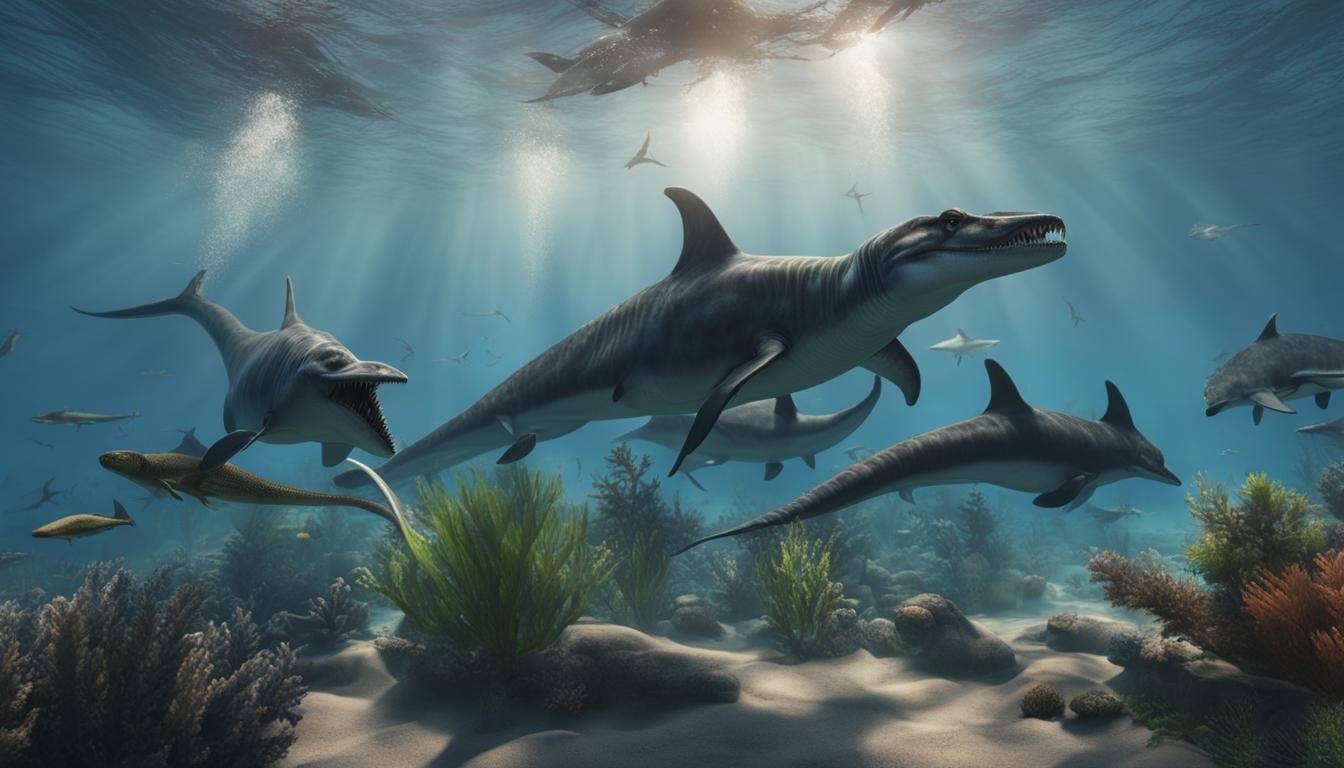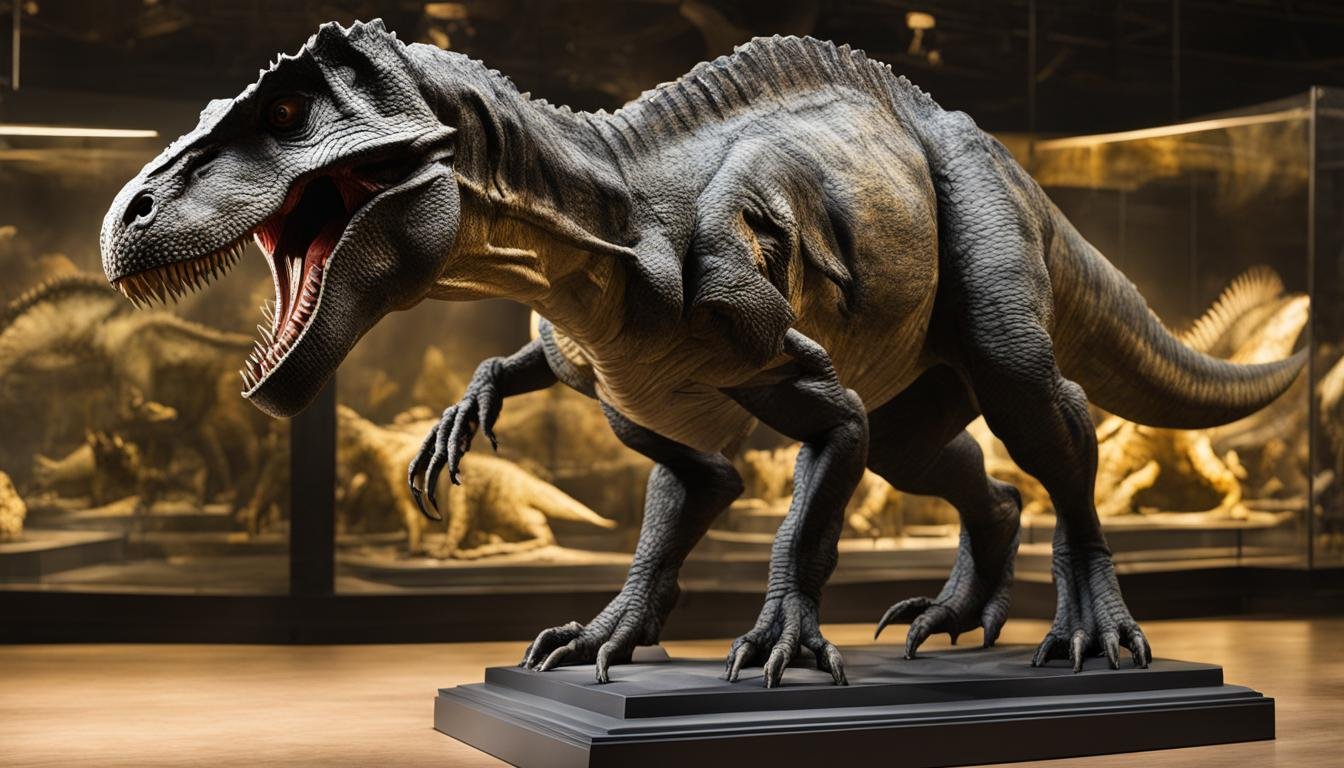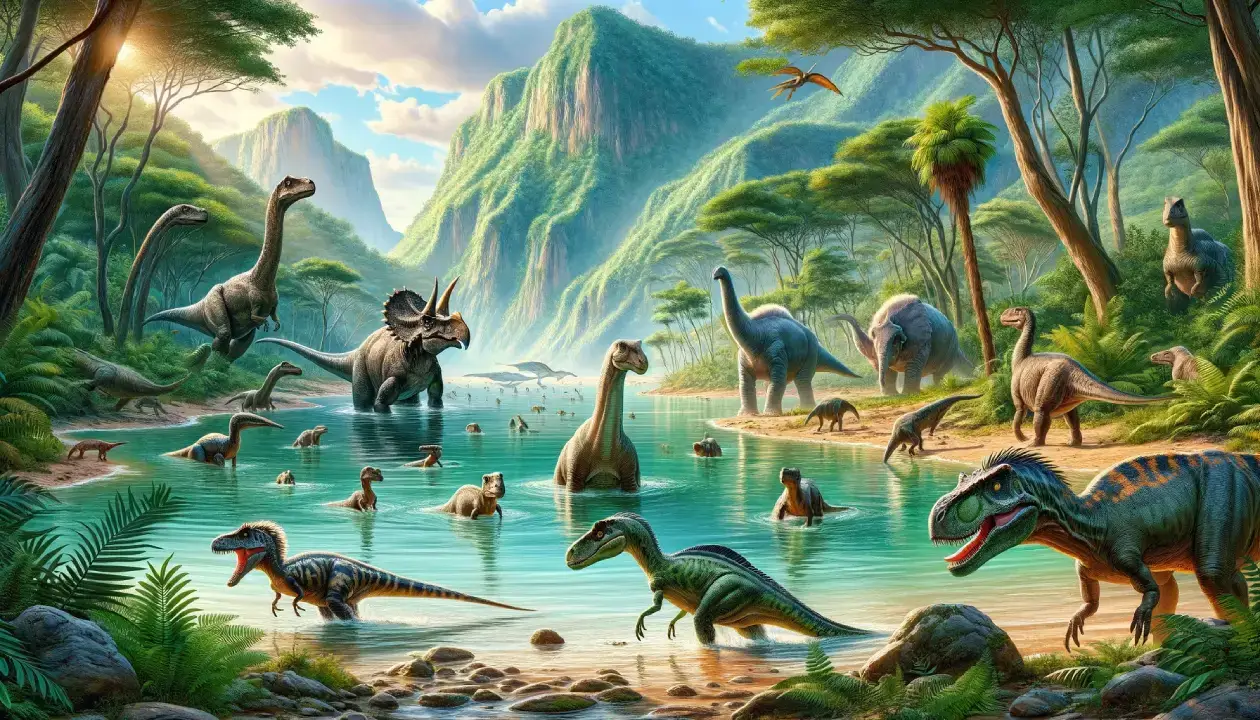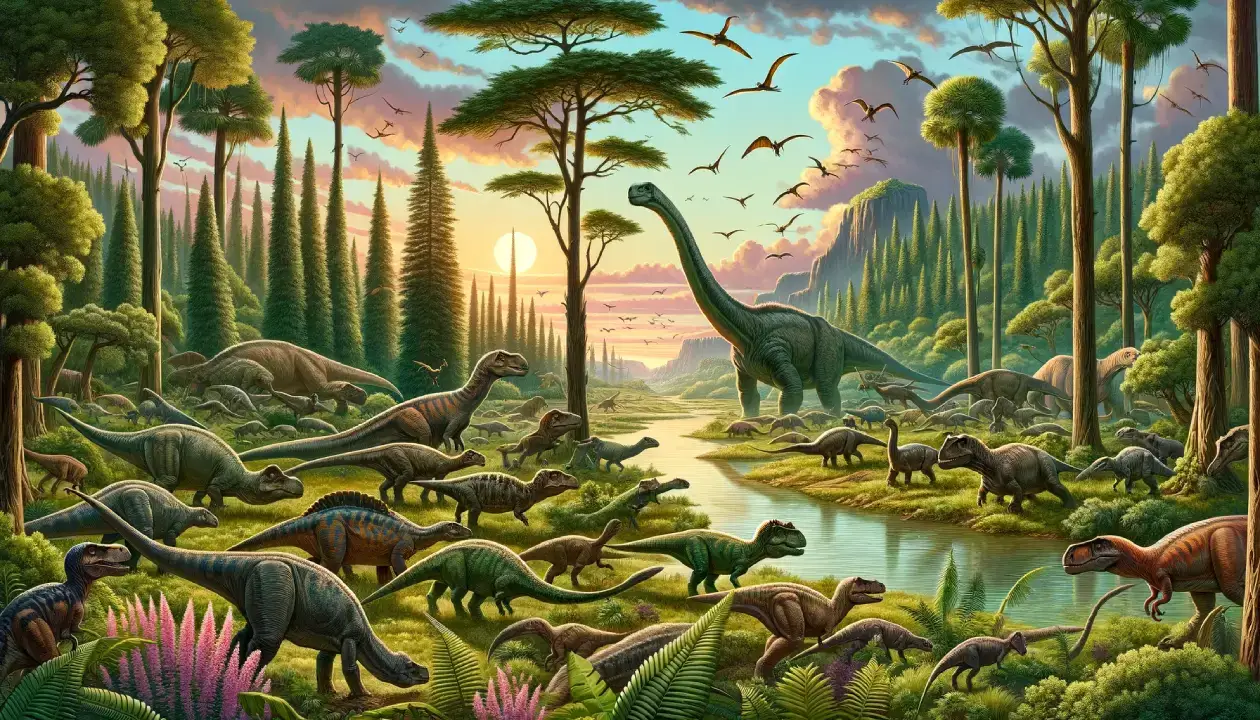Water dinosaurs, also known as aquatic dinosaurs, were a diverse group of prehistoric reptiles that evolved adaptations for living in aquatic environments. They had paddle-like limbs, streamlined bodies, tail fins, and webbed feet that allowed them to swim with ease. These features gave them a hydrodynamic design and helped them navigate through the water. Some aquatic dinosaurs also had dorsal fins, gills, and specialized respiratory systems for improved swimming ability and oxygen efficiency. They developed underwater vision and a blubber layer for insulation, and their bodies were adapted for buoyancy control. These unique physical features allowed aquatic dinosaurs to thrive in marine ecosystems and play an important role in shaping the biodiversity of the Mesozoic Era.
Types of Aquatic Dinosaurs
There were several major types of water dinosaurs, including plesiosaurs, ichthyosaurs, and mosasaurs. Each of these aquatic dinosaurs had distinct physical features and adaptations that suited their specific habitats and lifestyles.
Plesiosaurs
Plesiosaurs were characterized by their long necks, small heads, and four paddle-like limbs. Ranging in size from a few feet to over 40 feet in length, they were adept at catching fish, squid, and other marine reptiles with their sharp teeth. Plesiosaurs were well-suited for an aquatic lifestyle and their flexible bodies allowed them to maneuver through the water with ease.
Ichthyosaurs
Ichthyosaurs had streamlined bodies, large eyes, and a long snout filled with sharp teeth. These fast-swimming predators inhabited oceans around the world and primarily fed on fish and squid. Their unique physical features enabled them to chase prey in low-light conditions and dive deep for food.
Mosasaurus
Mosasaurus were large predators with long, slender bodies, paddle-like limbs, and powerful tails. They had sharp teeth and were capable of hunting a variety of prey, including fish, turtles, and other marine reptiles. These apex predators played a significant role in marine ecosystems and showcased the diversity of aquatic dinosaurs.
By understanding the different types of aquatic dinosaurs, we gain insights into the remarkable adaptations and physical characteristics that allowed them to thrive in aquatic environments. These fascinating creatures have left a lasting legacy in the fossil record, providing valuable information about our planet’s prehistoric past.
| Types | Physical Features |
|---|---|
| Plesiosaurs | Long necks, small heads, four paddle-like limbs, sharp teeth |
| Ichthyosaurs | Streamlined bodies, large eyes, long snout with sharp teeth |
| Mosasaurus | Long, slender bodies, paddle-like limbs, powerful tails, sharp teeth |
Size and Physical Characteristics of Aquatic Dinosaurs
Aquatic dinosaurs exhibited a wide range of sizes and physical characteristics, making them a diverse group of prehistoric reptiles. These fascinating creatures varied from small species measuring a few feet in length to massive giants reaching up to 50 feet or more. Their bodies were streamlined and designed for efficient swimming, with powerful tails propelling them through the water with agility. Many aquatic dinosaurs had limbs adapted into flippers or paddle-like structures, enabling them to navigate their watery habitats with ease.
The physical characteristics of aquatic dinosaurs also included features such as long, sharp teeth, which allowed them to catch and consume their prey. Some species even possessed specialized structures in their jaws for crushing hard-bodied prey. These adaptations in their dental structures provided insight into their feeding habits and dietary preferences. Additionally, aquatic dinosaurs had unique respiratory systems, sensory organs, and adaptations for buoyancy control, further highlighting their remarkable physical traits.
| Physical Characteristics |
|---|
| Streamlined bodies |
| Paddle-like limbs or flippers |
| Long, sharp teeth |
| Specialized jaws for crushing prey |
| Unique respiratory systems |
| Sensory adaptations |
| Buoyancy control mechanisms |
Despite the variations in size and physical characteristics, all aquatic dinosaurs shared common traits that allowed them to thrive in their aquatic environments. These shared features include their hydrodynamic design, which enhanced their swimming abilities, and adaptations for improved oxygen efficiency. It is through these remarkable physical traits that aquatic dinosaurs were able to shape the biodiversity of the Mesozoic Era, leaving behind a rich fossil record that continues to captivate scientists and enthusiasts alike.
Habitats and Geographic Distribution of Aquatic Dinosaurs
Aquatic dinosaurs inhabited various habitats, including oceans, rivers, lakes, and coastal regions. They were well-adapted to different water environments, such as freshwater and saltwater. The distribution of aquatic dinosaurs was influenced by factors like sea-level fluctuations and geodispersal. Fossil evidence reveals that these prehistoric reptiles had a global presence during the Mesozoic Era, with fossils discovered in regions such as North America, North Africa, Europe, Asia, Australia, and Munich, Germany. Their stratigraphic distribution varied based on the availability of suitable habitats and resources.
The presence of aquatic dinosaurs was not limited to shallow waters; they also thrived in deep waters. These extraordinary creatures inhabited diverse aquatic ecosystems, contributing to the shaping of marine biodiversity during their time. Their ability to adapt to different habitats and geographic regions highlights their evolutionary success and widespread distribution across the globe.
| Aquatic Dinosaur | Habitats | Geographic Distribution |
|---|---|---|
| Plesiosaurs | Oceans, rivers, lakes, and coastal regions | Worldwide distribution |
| Ichthyosaurs | Oceans around the world | Global distribution |
| Mosasaurus | Oceans, rivers, lakes, and coastal regions | Global distribution |
These tables showcase the diverse habitats and wide geographic distribution of aquatic dinosaurs, emphasizing their adaptability to different water environments and their significant presence throughout the Mesozoic Era.
Diet and Hunting Strategies of Aquatic Dinosaurs
Aquatic dinosaurs had a diverse diet that varied based on their size, shape, and habitat. These prehistoric reptiles were apex predators, and their diet consisted primarily of fish, squid, and other marine creatures. Larger species like mosasaurs were top predators and could hunt a variety of prey, including other marine reptiles. These aquatic dinosaurs were well-equipped for hunting in water environments, with unique physical features and adaptations.
“Aquatic dinosaurs had different hunting strategies based on their adaptations.” Some species used speed and agility to ambush their prey from below, while others relied on their long necks to sneak up on unsuspecting prey. These dinosaurs were adept at stalking and capturing their prey, using their sharp teeth to catch and swallow whole. Their streamlined bodies and powerful tails allowed them to move swiftly through the water and quickly overtake their prey.
Understanding the diet and hunting strategies of aquatic dinosaurs provides valuable insights into their role in marine ecosystems. By examining the fossil record and studying the physical characteristics of these creatures, scientists can piece together the puzzle of how they lived and interacted with their environment. The study of diet and hunting strategies helps us paint a more complete picture of these fascinating and powerful creatures that once ruled the ancient seas.
| Aquatic Dinosaur | Diet | Hunting Strategy |
|---|---|---|
| Plesiosaurs | Fish, squid, marine reptiles | Ambush predators, used speed and agility |
| Ichthyosaurs | Fish, squid | Fast swimmers, chased prey in low-light conditions |
| Mosasaurus | Fish, turtles, marine reptiles | Top predators, hunted a variety of prey |
Fossil Discoveries and Paleontology of Aquatic Dinosaurs
The study of fossil discoveries and paleontology has provided valuable insights into the evolution and behavior of aquatic dinosaurs. Fossils of aquatic dinosaurs have been found in various locations around the world, including North America, Europe, Africa, Asia, Australia, and Munich, Germany. These fossils have helped scientists understand the physical characteristics, habitats, and diets of different species of aquatic dinosaurs.
Paleontologists rely on fossils and scientific methods to reconstruct the history and behavior of aquatic dinosaurs. By examining fossilized bones, teeth, and other remains, they can piece together the anatomy and lifestyle of these ancient creatures. Fossils also offer clues about the environments in which aquatic dinosaurs lived, such as the presence of marine sediments or signs of marine life in their stomach contents.
| Fossil Discoveries and Paleontology | Insights |
|---|---|
| Location | Worldwide (North America, Europe, Africa, Asia, Australia, and Munich, Germany) |
| Physical Characteristics | Helped reconstruct the anatomy and adaptations of aquatic dinosaurs |
| Diet and Habitat | Provided information on the diets and habitats of different species |
| Evolution and Behavior | Contributed to understanding the evolutionary history and behavior of aquatic dinosaurs |
Ongoing research and new discoveries continue to expand our knowledge of these fascinating creatures. By studying the fossil record, paleontologists can uncover more details about the diversity, distribution, and ecological roles of aquatic dinosaurs. These findings help paint a clearer picture of the Mesozoic Era and the ancient oceans that were once teeming with these remarkable prehistoric reptiles.
Spinosaurus: The Aquatic Dinosaur
Spinosaurus is a legendary aquatic dinosaur that roamed the ancient oceans during the Late Cretaceous period. It is one of the most well-known examples of an aquatic dinosaur, capturing the imagination with its unique adaptations and imposing size. This dinosaur had a long, crocodile-like snout, a sail on its back, and powerful arms with sharp claws. These features, along with its streamlined body, made Spinosaurus a formidable predator in water environments.
Spinosaurus was well-suited to an aquatic lifestyle, as evidenced by its adaptations for swimming and hunting underwater prey. It lived in rivers and lakes, where it hunted fish and other aquatic creatures. With its large size, reaching lengths of up to 50 feet, Spinosaurus was one of the largest carnivorous dinosaurs known to exist. Its aquatic adaptations allowed it to navigate through the water with ease and thrive in marine ecosystems.

Spinosaurus was a true aquatic dinosaur, showcasing the wide range of physical features and adaptations seen in this group. Its long snout, sail-like structure, and powerful arms set it apart from other dinosaurs and highlighted its specialization for life in the water.
Spinosaurus continues to fascinate scientists and enthusiasts alike, offering valuable insights into the diverse world of aquatic dinosaurs. Its unique physical features and adaptations contribute to our understanding of the evolution and behavior of these prehistoric creatures. The study of Spinosaurus and other aquatic dinosaurs fuels ongoing research and exploration, shedding light on the remarkable diversity that once thrived in the ancient oceans.
Plesiosaurus: The Aquatic Dinosaur with a Long Neck
The Plesiosaurus is a well-known example of an aquatic dinosaur that captivates the imagination with its long neck and unique physical features. This ancient marine reptile had a streamlined body, a small head, and four paddle-like limbs, making it a fascinating creature to study. The Plesiosaurus ranged in size, with some individuals measuring only a few feet long while others reached lengths of over 40 feet.
The long neck of the Plesiosaurus was a remarkable adaptation that allowed it to maneuver through the water with ease. This flexibility, combined with its streamlined body, enabled the Plesiosaurus to glide swiftly through the ocean, hunting for fish, squid, and other marine reptiles. Its sharp teeth were well-suited for catching and consuming its prey, showcasing the predatory nature of this ancient creature.
The Plesiosaurus remains an iconic representation of aquatic dinosaurs with long necks. Its unique physical characteristics and adaptations highlight the diverse range of prehistoric creatures that once roamed the ancient oceans. Fossil discoveries continue to provide valuable insights into the evolution and behavior of the Plesiosaurus and other aquatic dinosaurs, further enriching our understanding of the incredible world that existed millions of years ago.
Mosasaurus: The T-Rex of the Sea
Mosasaurus is often referred to as the T-Rex of the sea due to its dominance as a top predator in aquatic ecosystems. This formidable aquatic dinosaur had a long, slender body, paddle-like limbs, and a powerful tail, making it a skilled swimmer. With its streamlined body, Mosasaurus could reach impressive speeds in the water, allowing it to chase down its prey with ease.
Measuring up to 50 feet in length, Mosasaurus was one of the largest aquatic dinosaurs. Its sharp teeth and powerful jaws were well-suited for hunting a variety of prey, including fish, turtles, and even other marine reptiles. This carnivorous predator played a crucial role in maintaining the balance of marine ecosystems during the Late Cretaceous period.
Mosasaurus was a force to be reckoned with in the ancient seas, showcasing the diversity and adaptability of aquatic dinosaurs. Its reputation as the T-Rex of the sea is well-deserved, as it ruled the waters with its size and predatory prowess.
| Feature | Description |
|---|---|
| Size | Up to 50 feet in length |
| Physical Characteristics | Long, slender body, paddle-like limbs, powerful tail |
| Diet | Fish, turtles, other marine reptiles |
| Habitat | Aquatic environments, both shallow and deep waters |
| Role in Ecosystem | Top predator, maintaining balance in marine ecosystems |
The dominance of Mosasaurus in the ancient seas demonstrates the remarkable adaptability and diversity of aquatic dinosaurs. Its powerful presence as the T-Rex of the sea highlights the fascinating world of prehistoric marine life and the incredible creatures that once roamed the oceans.
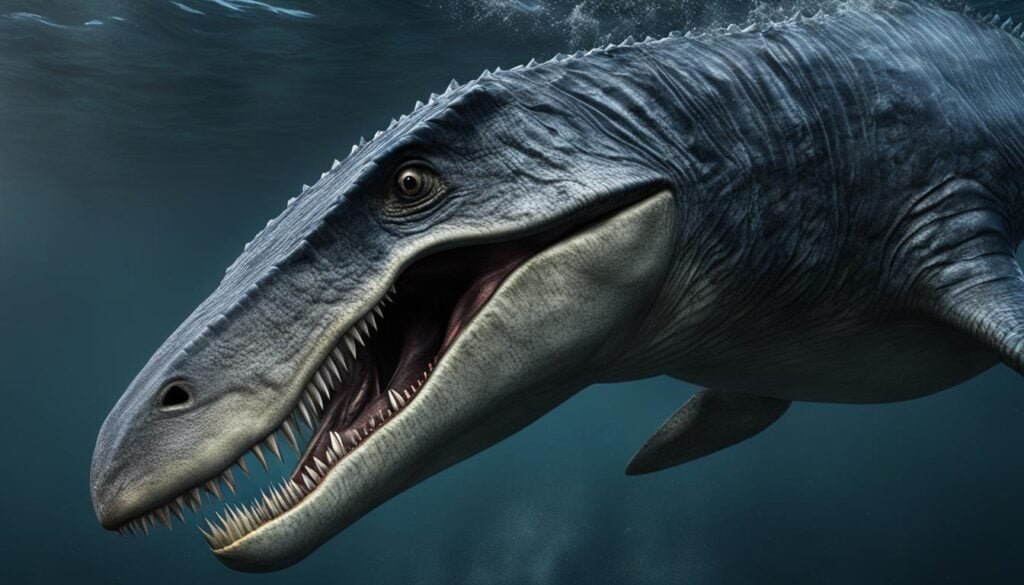
Ichthyosaurs: The Largest Aquatic Dinosaurs
One of the most fascinating types of aquatic dinosaurs is the ichthyosaurs. These prehistoric reptiles were known for their incredible size and unique adaptations to life in the water. With their streamlined bodies and powerful tails, ichthyosaurs were highly efficient swimmers, allowing them to navigate the ancient oceans with ease. They ranged in size from small species measuring a few feet long to giant giants reaching lengths of up to 50 feet or more. This made them some of the largest aquatic dinosaurs that ever lived.
The physical characteristics of ichthyosaurs were specifically designed for an aquatic lifestyle. They had long, slender bodies similar to modern dolphins or sharks, which enabled them to swim quickly and efficiently through the water. Their limbs were modified into paddle-like structures, making them well-suited for life in the ocean. Ichthyosaurs also had large eyes, indicating their ability to hunt in low-light conditions and dive to significant depths in pursuit of prey.
One of the most intriguing aspects of ichthyosaurs is their method of reproduction. Fossil evidence suggests that these aquatic dinosaurs gave birth to live young, similar to modern-day whales. This reproductive strategy allowed ichthyosaurs to thrive and adapt to their watery environments, ensuring the survival of their species for millions of years. The combination of their impressive size, physical adaptations, and unique reproductive behavior makes ichthyosaurs a truly remarkable group of aquatic dinosaurs.
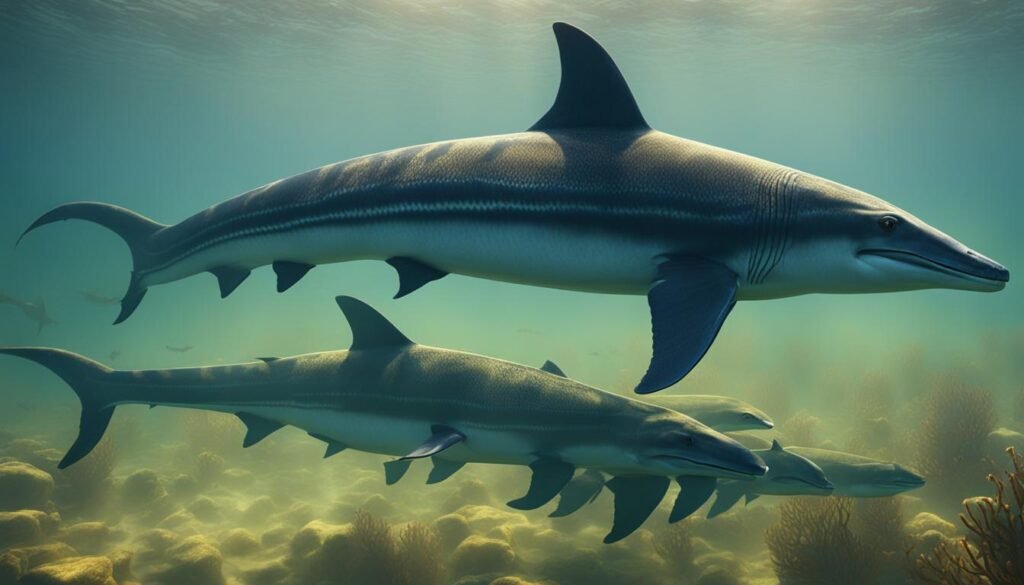
Aquatic Dinosaurs: A Roster of Legends
The world of aquatic dinosaurs is filled with a roster of legendary creatures. From the long-necked plesiosaurs to the sharp-toothed mosasaurs, these prehistoric ocean dwellers captivate our imaginations. Each species had its own unique physical features, adaptations, and role in the marine ecosystems of the past.
| Aquatic Dinosaurs | Physical Features | Adaptations |
|---|---|---|
| Plesiosaurs | Long necks, small heads, paddle-like limbs | Streamlined bodies, sharp teeth for catching prey |
| Mosasaurs | Long, slender bodies, paddle-like limbs | Powerful tails, sharp teeth for hunting prey |
| Ichthyosaurs | Streamlined bodies, large eyes, long snout | Sharp teeth, ability to hunt in low-light conditions |
These aquatic dinosaurs played a significant role in shaping the biodiversity of the ancient oceans. Fossil discoveries continue to expand our understanding of these incredible creatures and their place in prehistoric history. Ongoing research provides valuable insights into their evolution, behavior, and prominence in marine ecosystems.
“Aquatic dinosaurs existed in a world vastly different from our own, but their adaptations and physical traits have left an indelible imprint on the fossil record. They inspire awe and curiosity, reminding us of the diverse and remarkable creatures that once roamed the ancient oceans.”
Aquatic Dinosaurs in Popular Culture
- Books and movies like “Jurassic Park” have brought these legendary creatures to life, sparking the imagination of people of all ages.
- Museums around the world showcase fossil specimens and exhibits dedicated to aquatic dinosaurs, allowing visitors to get a glimpse of these awe-inspiring creatures.
- Scientific discoveries and research in paleontology continue to fuel our fascination with aquatic dinosaurs and shed light on their place in Earth’s history.
The legacy of aquatic dinosaurs lives on in our collective consciousness and serves as a testament to the incredible diversity of life that once inhabited our planet’s ancient oceans.

Conclusion
Aquatic dinosaurs were fascinating prehistoric reptiles that adapted to life in water environments. With their unique physical features and adaptations, they thrived in marine ecosystems and played a crucial role in the biodiversity of the Mesozoic Era.
These diverse creatures, including plesiosaurs, ichthyosaurs, and mosasaurs, had streamlined bodies, paddle-like limbs, and other specialized characteristics that allowed them to swim and hunt with ease. Their physical traits varied, but they all shared common features that helped them survive and thrive in aquatic habitats.
Thanks to the study of fossil discoveries and paleontology, scientists have gained valuable insights into the evolution and behavior of aquatic dinosaurs. Ongoing research and new discoveries continue to expand our understanding of these incredible creatures and their place in the ancient oceans.
In conclusion, the world of aquatic dinosaurs is a captivating one, filled with legendary creatures and remarkable adaptations. As we continue to uncover more about these fascinating reptiles, we gain a deeper appreciation for the diversity and complexity of life in the prehistoric seas.

